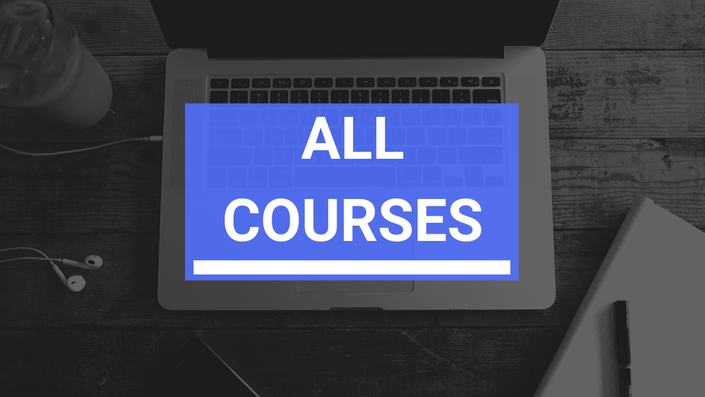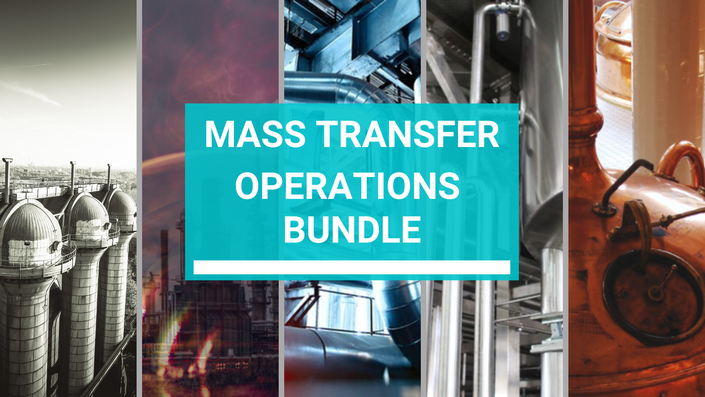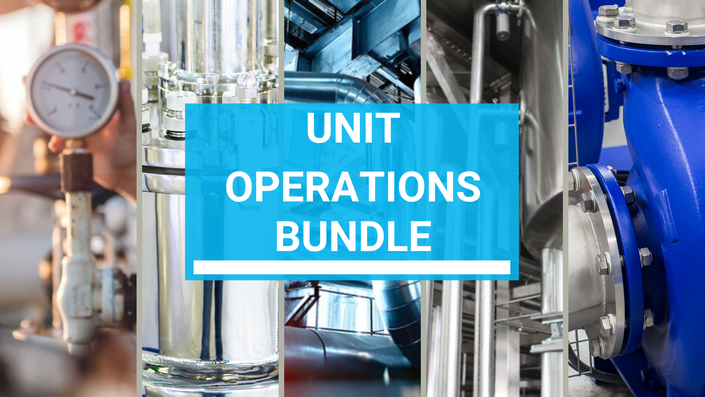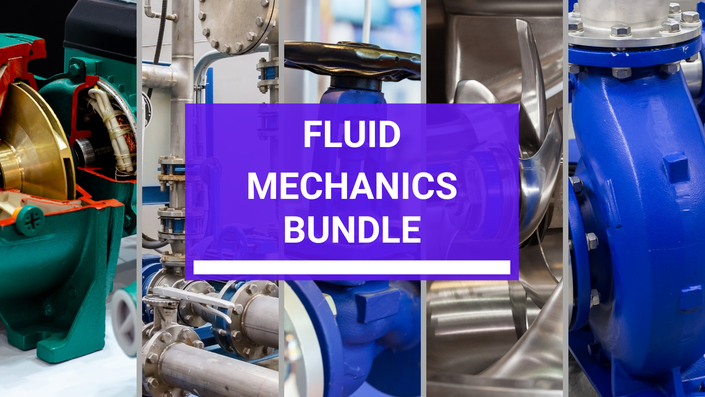Course Trailer
About this Course
📚 This Mass Transfer Principles for Vapor-Liquid Unit Operations course focuses on the fundamental mass transfer phenomena that govern vapor-liquid separations. You will gain the knowledge necessary to design, optimize, and troubleshoot advanced distillation, absorption, and extraction systems, key operations in chemical and process industries.
Key topics covered include:
- Fundamentals of Mass Transfer
- Vapor-Liquid Equilibrium and Raoult’s Law
- Mass Transfer in Distillation Columns
- Absorption and Extraction Processes
- Design and Optimization of Mass Transfer Equipment
- Internal Resistance and Overall Efficiency in Unit Operations
👨🏫 Designed for
Chemical engineering students, process engineers, and professionals seeking to deepen their understanding of mass transfer operations and improve the design and optimization of vapor-liquid separation systems.
📚 Course Approach
The course combines a thorough review of theoretical principles with practical design examples, simulations, and case studies to showcase real-world applications.
🎯 By the end of the course, you will be able to:
- Understand the core principles of mass transfer in vapor-liquid systems
- Analyze the performance of distillation, absorption, and extraction systems
- Design and optimize separation processes based on mass transfer principles
- Evaluate the efficiency of mass transfer equipment and troubleshoot operational issues
- Use process simulation tools to model mass transfer operations
🚀 Recommended for
Students, engineers, and industry professionals aiming to master vapor-liquid mass transfer operations, and those involved in the design and optimization of separation systems in the chemical, petrochemical, and pharmaceutical industries.
✅ You’ll learn to:
- Apply mass transfer principles to optimize distillation, absorption, and extraction processes
- Calculate key parameters like mass transfer coefficients and stage efficiencies
- Design and model distillation and absorption columns using mass transfer concepts
- Improve process efficiency and throughput by optimizing mass transfer rates
- Use simulation tools to model and analyze mass transfer systems for complex separations

Self-Paced, Dynamic Lectures
Learn at your own pace, anytime and anywhere.
The lectures are concise, engaging, and focused—designed to maximize your understanding efficiently.

Example Title
Use this block to showcase testimonials, features, categories, or more. Each column has its own individual text field. You can also leave the text blank to have it display nothing and just showcase an image.

Evaluations, Quizzes
Evaluate your progress through interactive quizzes and self-assessments.
Reinforce key concepts, identify gaps, and ensure you're ready to apply what you've learned in real scenarios.

30 Day Money-Back Warranty
Enroll with confidence—if the course doesn’t meet your expectations, you can request a full refund within 30 days.
No questions asked.

Certificate of Completion
Receive an official certificate or diploma once you finish the course—perfect for showcasing your new skills on your resume, LinkedIn, or job applications.

Instructor Support
Get guidance whenever you need it—ask questions, request feedback, and interact directly with the instructor throughout the course.
Curriculum
- Welcome to the Course! (1:46)
- Content Index (6:23)
- Objectives & Goals (4:13)
- Why Mass Transfer in Vapor-Liquid & Gas-Liquid Operations? (4:55)
- Difference between a Vapor and Gas (5:07)
- Task - Check my old Vid on Gas vs Vapor (1:06)
- What are Vapor-Liquid Processes? (1:17)
- Absorption, Desorption, Stripping & Scrubbing (4:14)
- Task - Amine Gas Treating Unit (1:25)
- Distillation Types (2:50)
- Task - Distillation Column (0:52)
- Reference Books & Materials (3:12)
- Some Notes (Teachable) (2:55)
- Join the Groups! (1:41)
- Contact Me (1:04)
- Reference Material
- Test yourself! Do you need to take the review?
- Section 2 - Overview (2:50)
- 2.1 Basic Topics
- Ideal Gas Law (3:43)
- Ideal Solution (5:02)
- Concept of Ideality (2:36)
- Real Gas - Overview (2:06)
- Ex. Ideal vs Real Gas Conditions (3:56)
- Animation - Compressibility Factor Charts (3:48)
- Non-Ideal Solutions (4:49)
- Vapor Pressure (5:29)
- Partial Pressure (3:44)
- Partial Pressure vs Vapor Pressure (3:42)
- Animation- Dalton's Law of Partial Pressures (2:29)
- Ex. Calculate Vapor & Pressure
- Task – Partial & Vapor Pressure (0:38)
- What is a Phase? (2:03)
- The Concept of Solubility (5:30)
- Animation - Dissolving a Solute (2:26)
- General Concept of Equilibrium (3:13)
- Phase Equilibrium (4:49)
- Solubility Equilibrium (3:43)
- 2.2 Vapor Liquid Equilibrium
- What is Vapor Liquid Equilibrium for Pure Substances (4:36)
- Vapor Liquid Equilibrium for Binary Systems (6:55)
- Animation - Pxy and Txy Diagrams for Vapor Liquid Equilibriums (3:17)
- Volatility (Chemistry) (4:25)
- Task - Volatility of Substances (1:36)
- Relative Volatility (8:06)
- Special Case - Constant Relative Volatility (2:37)
- Animation - Flash Distillation of a Constant Relative Volatility Mixture (2:37)
- K-Values - An Overview (2:27)
- Task - Calculate K-Values (4:01)
- Animation - K-value of Several Hydrocarbons versus Temperature and Pressure (4:17)
- 2.3 Equilibrium Diagrams
- Equilibrium Diagrams (3:38)
- Gibbs Phase Rule (4:48)
- Phase Rule & Diagrams (5:24)
- Animation Gibbs Phase Rule for One and Two Component Systems (3:28)
- Task - Prove Phase Rule for VLE systems (2:18)
- Binary Diagrams (1:45)
- XY Diagrams (3:41)
- Task - XY Diagram (2:21)
- T-XY Diagram (3:26)
- Bubble Point (3:03)
- Dew Point (2:38)
- Analysis of T-XY Diagram (5:31)
- Task - Reading T-XY Diagram (0:41)
- Animation - Vapor Liquid Liquid Equilibrium (VLLE) (2:41)
- P-XY Diagrams (5:16)
- Task - Reading P-XY Diagrams (2:22)
- 2.4 VLE Thermodynamics
- Thermodynamics Fundamentals (3:52)
- Solving Ideal Gases (3:49)
- Solving via Activity Models (3:28)
- Task - Activity Models (1:08)
- Solving Equation of States (EOS) Cases (1:15)
- Task – Fitting Data to Peng Robinson EOS (6:27)
- Cases (1:18)
- Case 1 - Ideal Solution & Ideal Gas (1:18)
- Raoult's Law (7:16)
- Ex. Raoults Law Application (9:09)
- K-Values (revisited) (2:55)
- Case 2 - Real Solution - Ideal Gas (3:33)
- Case 3 - Ideal Solution and Real Gas (2:36)
- Case 4 - Real Solution - Real Gases (3:17)
- Cases Conclusions - Ideal Gases and Solutions vs Real Gases and Solutions (1:58)
- 2.5 Deviations of VLE
- Devitations (4:49)
- Animation: Vapor-Liquid Equilibrium Diagram for Non-Ideal Mixture
- Azeotropes (3:40)
- Animation Azeotropes of Binary Mixtures containing Ethanol (2:59)
- Miniumum boiling Azeotropes (4:04)
- Maximum Boiling Azeotrope (2:29)
- Task - Identify Azeotrope Types (1:26)
- EXTRA: Introduction to Azeotropic Distillation (2:20)
- 2.6 Bonus - Getting VLE Data
- What is Aspen Plus? (1:31)
- Getting VLE Data from Aspen Plus (2:41)
- Task - Graphing Txy Data with Binary Analysis Tools (6:05)
- Getting VLE Data from NIST Databases (3:13)
- Task - Extracting Binary Data using NIST Database (3:27)
- 2.7 Gas Solubility in Liquids
- Gas Solubility in Liquids an Overview (8:12)
- Equilibrium Distribution Curve for Solubility (5:44)
- Examples - Equilibrium Distribution Curve in Solubility (2:02)
- Task - Equilibirum Distribution Curve Analysis (3:12)
- Gas Solubility in Liquids - Analysis (4:05)
- Henry's Law (11:48)
- Animation Henrys Law for Gases Dissolved in Water (3:35)
- Animation Temperature Dependance of Henrys Law Constant (3:25)
- Ex. Henry’s Law for Solubility
- Section 2 - Closure (0:38)
- Section 3 - Overview (1:04)
- Before we start (1:39)
- 3.1 Introduction to Mass Transfer
- What is Mass Transfer? (11:22)
- Types of Mass Transfer (2:06)
- Introduction to Mass Diffusion (2:41)
- Task - Molecular Diffusion in Dyes (1:04)
- Animation - Diffusion of Gases in a Tube (3:11)
- The Concept of Velocity in Mass Transfer (11:00)
- What is Molar Flux? NA (3:57)
- What is Moalr Flux due to Molecular Diffusion? JA (1:39)
- Ex. Mass, Molar and Volumetric Average Velocities (7:53)
- What is Molecular Diffusion? (3:09)
- Diffusion of Gases (4:09)
- Eddys vs Molecular Diffusion (0:46)
- Task - Identify Molecular Diffusvion vs. Convective Mass Transfer (2:05)
- Diffusivity aka Diffusion Coefficient - DAB (3:56)
- Animation - Binary Diffusion Coefficients for Gases (2:42)
- Animation - Diffusion Coefficients for Multicomponent Gases (1:55)
- 3.2 Fick’s Law
- Models for Diffusion (2:33)
- Ficks Law (6:30)
- Animation - Steady-State Binary Fickian Diffusion (3:41)
- Understanding Applications of Diffusion in Engineering (4:12)
- Case A) Equimolar Counter Diffusion (EMD) (13:26)
- Ex. 1 Equimolar Counter Diffusion (8:52)
- Ex. 2 Equimolar Counter Diffusion Application (11:28)
- Tip - Location vs. Time in Diffusion (3:13)
- Ex. 3 Equimolar Counter Diffusion in Pressure, Concentration and Molar Fractions (5:57)
- Ex. 4 Equimolar Counter Diffusion using Pressure (4:19)
- Case B) Unimolecular Diffusion (UMD) (5:02)
- About the Cases we are studying... (1:00)
- Unimolecular Diffusion Formula using Concentrations (6:53)
- Unimolecular Diffusion Equations using Partial Pressures (6:36)
- Unimolecular Diffusion Equations for Molar Fractions (4:13)
- Summary of Equations for Unimolecular Diffusion (2:44)
- Ex 1. Unimolecular Diffusion of Oxygen using Partial Pressures (7:21)
- Ex. 2 Unimolecular Diffusion of Benzene in Air (24:07)
- Ex. 3 Unimolecular Diffusion of Evaporization of Water in Air (5:28)
- Section 3 - Closure (1:31)
- Test Yourself! Section 3.
- Section 4 - Overview (2:06)
- 4.1 Introduction to Convective Mass Transfer
- Overview of Convective Mass Transfer (0:46)
- Mass Transfer Cases (3:57)
- Task - Convective Mass Transfer (1:00)
- Convective Mass Transfer (2:02)
- 4.2 Mass Transfer Coefficients
- Mass Transfer Coefficients (MTC) (12:46)
- MTC for Molecular Diffusion (5:35)
- MTC for Molecular Diffusion Cases UMD & EMD (6:05)
- Mass Transfer Coefficient for Equimolar Counter-Diffusion (EMD) (10:39)
- Ex. MT Coefficient in EMD (10:33)
- Mass Transfer Coefficient for Unimolecular Diffusion (UMD) (12:03)
- Ex. 1 MT Coefficient in UMD (6:01)
- Ex 2. MT Coefficient in UMD with Non Diluted Solution (6:04)
- MT Coefficients Summary (2:06)
- Volumetric MT Coefficients (3:37)
- Analogies between Momentum, Heat & Mass Transfer (7:53)
- Task - Chilton Colburn Analogy (1:11)
- 4.3 MT Coefficient Correlations
- Mass Transfer Correlations (8:09)
- Mass Transfer Correlation for Fluids Flowing Thorugh Pipes (4:39)
- Ex. MTC Correlation for Fluids Flowing Through Pipes (7:35)
- Mass Transfer Correlation for Flow in Packed Beds (3:26)
- Ex. MTC Correlation for Fluids in Packed Beds (7:47)
- More on MTC Correlations (1:24)
- Section 4 - Closure (1:06)
- Test Yourself! Section 4
- Overview of Section 5 (1:19)
- 5.1 Introduction to Mass Transfer within Interphases
- Introduction to Mass Transfer in Interphases (5:29)
- What is an Interphase? (2:44)
- Revisiting Equilibrium for Gas Liquid and Vapor Liquid Operations (11:06)
- Raoult's Law Revisited for Equilibrium Operations (2:00)
- Ex. Application of Raoult's Law to a Binary System (7:22)
- Henry's Law - Revisited (2:06)
- Ex. Henry's Law used in Saturation of Oxygen & Solubility (5:54)
- 5.2 Theories for Diffusion between Phases
- Interphase Mass Transfer (5:11)
- Theories for Interphase Mass Transfer (2:09)
- Original Film Theory (9:12)
- Ex. Calculating Mass Transfer Coefficient and Film Thickness with Film Theory in a Packed Absorber (9:23)
- The Penetration Theory (6:19)
- Surface Renewal Theory (6:12)
- Film Penetration Model (3:02)
- Surface Stretch Theory (1:23)
- Summary of Interphase Mass Transfer Theories (1:51)
- Overview of the Two Film - Two Resistance Theory (3:06)
- 5.3 Two Film Theory Applied to Industrial Processes
- Films in Gas Absorption (3:12)
- Review of Film Concept for Mass Transfer Operations (1:56)
- Film-Film Interaction in the Two Resistance Theory (5:16)
- Two Film Theory & Equilibrium Solubility Curve for Gas Absorption (7:38)
- Analysis of Mass Transfer Process using Two Film Theory (4:25)
- Mass Transfer Coefficients in Two Film Theory (3:00)
- Local Mass Transfer Coefficients (kx & ky) (5:57)
- Overall Mass Transfer Coefficients (KX & KY) (4:03)
- Task - Overall Mass Transfer Coefficient (2:01)
- Local vs. Overall Mass Transfer Coefficients (2:43)
- Mass Transfer Resistance (1/kx & 1/ky) (2:25)
- Analysis of Gas Solubility using Mass Transfer Coefficients & Resistances (9:41)
- Ex. Mass Transfer Coefficients Resistance in Gas Absorption (Local & Overall) (10:01)
- Ex. Gas Absorption of SO2 into Water (Local vs Overall MTC) (7:59)
- Section 5 - Closure (1:12)
- Test Yourself! Section 5
Course Enrollment
This and all other courses are available only via the All Courses - One Subscription Membership.

Hi, I’m Emmanuel Ortega,
a.k.a. the Chemical Engineering Guy!
With five years in the chemical industry, from petrochemical plant design to polyester textiles, I bring real-world experience to show the true value of engineering knowledge.
My Expertise:
- Process Simulation & Optimization
- Chemical Process Design
- Process Equipment Design
- Automotive & Industrial Polyester Yarn Technologies
- Online Tutoring, Online Education Management
The Courses I design are entirely dynamic. You will see theory and then apply it ASAP to a real life problem! I even use the books you are using right now in your engineering courses...
I'll see you in class!
Frequently Asked Questions (FAQ)
- When does the course start and finish?
- The course starts now and never ends! It is a completely self-paced online course - you decide when you start and when you finish.
- How long do I have access to the course?
- *How does lifetime access sound? After enrolling, you have unlimited access to this course for as long as you like - across any and all devices you own.
- NOTE*: This is true as long as you keep your subscription active.
- What if I am unhappy with the course?
- We would never want you to be unhappy! If you are unsatisfied with your purchase, contact us in the first 30 days and we will give you a full refund.
- Will I Get a Certificate/Diploma of Completion?
- Yes! After the course, you will get a Certificate of Completion with a Diploma! You can use this in your Resume!
- Are Resources Downloadable?
- Absolutely YES! Every resource is available for download, allowing you to study alongside them.
- Any doubt? Message me!
- Please reach out! [email protected]




